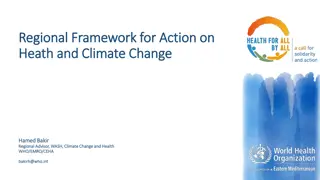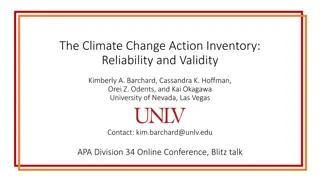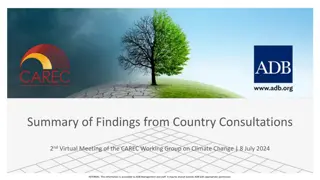Programme for the Environment and Climate Action (LIFE)
The LIFE Programme 2021-2027 focuses on eco-innovative techniques, nature conservation, and biodiversity restoration in the Natura 2000 network. The initiative aims to implement EU legislation, promote best practices, and catalyze the deployment of sustainable solutions. Funding opportunities, application procedures, and relevant documents are available for interested participants.
Download Presentation

Please find below an Image/Link to download the presentation.
The content on the website is provided AS IS for your information and personal use only. It may not be sold, licensed, or shared on other websites without obtaining consent from the author.If you encounter any issues during the download, it is possible that the publisher has removed the file from their server.
You are allowed to download the files provided on this website for personal or commercial use, subject to the condition that they are used lawfully. All files are the property of their respective owners.
The content on the website is provided AS IS for your information and personal use only. It may not be sold, licensed, or shared on other websites without obtaining consent from the author.
E N D
Presentation Transcript
Programme for the Environment and Climate Action (LIFE) Grant Scheme for Biodiversity in the Outermost Regions and the Overseas Countries and Territories LIFE-2021-BEST INFO DAY 18/01/2022 Anita Fassio, Senior Project Adviser Unit D2 - LIFE Environment (Nature & Circular Economy)
The LIFE Programme 2021-2027 Projects Develop and demonstrate eco-innovative techniques and approaches Help to implement and enforce plans and strategies, in compliance with EU legislation. Promote best practices and behavioral changes Catalyse the large scale deployment of successful solutions On legislation and policies Support their development, monitoring and enforcement Help Member States to improve their implementation
Sub-programme Nature and Biodiversity Contribution to: Typical actions Projects supporting nature conservation and restoration in the Natura 2000 network . Species protection. Invasive Alien Species Ecosystem restoration and much more Halting and reversing biodiversity loss. SAPs Supporting Natura 2000 network and Prioritised Action Frameworks. Mainstreaming nature and biodiversity objectives into other policies and financing programmes. Integrated Biodivesrity Strategy implementation of PAF and SNAPs Financing of small scale grants, particularly in Overseas Countries Outermost Regions BEST and Territories and
Reference documents All the relevant documents can be found in the Funding & tender opportunities portal of the EC https://ec.europa.eu/info/funding-tenders/opportunities/portal/screen/home, at the specific call page LIFE- 2021-BEST Call document LIFE Work Programme 2021-2024 LIFE Regulation 2021/783 LIFE General Model Grant Agreement (MGA v1.0)
Application forms in the Submission System https://ec.europa.eu/info/funding-tenders/opportunities/portal/screen/home Standard Application Form: Part A (in system): General information Participants information High level Budget Part B (uploaded): Technical description Part C (in system): indicators Mandatory Annexes: Detailed budget table (uploaded) Participant information (uploaded) Optional Annexes: Letters of support Cofinancing declaration PLEASE USE THE OFFICIAL FORMS!
Available budget and timetable Project total budget Co-financing rate Estimated number of projects to be funded Expected project duration EU co-financing for the small grants Co-financing rate for the small grants EUR 100 000 max Up to 95% EUR 32 000 000 95% 1 project Maximum 120 months Timetable and deadlines (indicative) Call opening: 16 December 2021 Deadline for submission: 26 April 2022 17:00:00 CET (Brussels) Information on evaluation results: June 2022 GA signature: July 2022
Admissibility Criteria Proposals must be submitted before the call deadline Proposals must be submitted electronically via the Funding & Tenders Portal Electronic Submission System Proposals (including annexes and supporting documents) must be submitted using the forms provided inside the Submission System Project acronym Your project acronym must include the word LIFE Your application must be readable, accessible and printable Page limit must be respected - please do not delete the instructions in the application forms to gain more space
Eligibility Criteria Eligible participants/eligible countries In order to be eligible, the applicants (beneficiaries and affiliated entities) must: be legal entities (public or private bodies) be established in one of the eligible countries, i.e.: EU Member States - including Overseas Countries and Territories (OCTs) [non-EU countries: listed EEA countries and countries associated to the LIFE Programme (associated countries) or countries which are in ongoing negotiations for an association agreement and where the agreement enters into force before grant signature]* be active in the areas of nature conservation and climate change be active in EU s ORs and OCTs located in the Caribbean, Indian Ocean, Amazon, Pacific, Polar and Subpolar and Macaronesian Regions Beneficiaries and affiliated entities must register in the Participant Register before submitting the proposal Geographic location Proposals must relate to activities taking place in European Union s ORs and OCTs * The UK hasn t signed association agreement therefore UK participants and OTs are not eligible
Ineligible activities research; statutory responsibilities of the competent authority; activities outside the duration of the project; activities which are not clearly related to the objective(s) of the project; compensation measures; land purchase
Award criteria 4 award criteria matching Part B of the proposal Each criterion has a maximum of 20 points Impact criterion has weighting of 1.5 Total maximum points: 90 Award criteria Minimum pass score Maximum score Weighting Threshold: 55 1.Relevance 10 20 1 2. Impact 10 20 1.5 3.Quality 10 20 1 4.Resources 10 20 1 Overall weighted (pass) score 55 90 N/A
Award criterion 1 1. Relevance (0-20 points) Relevance of the contribution to one or several of the specific objectives of the LIFE Programme and the targeted sub-programme Extent to which the proposal is in line with the description included in the call for proposals, including, where relevant, its specific priorities Concept and methodology: soundness of the overall intervention logic Extent to which the proposal offers co-benefits and promotes synergies with other policy areas relevant for achieving environment and climate policy objectives
Award criterion 2 2. Impact (0-20 points) Ambition and credibility of impacts expected during and/or after the project due to the activities, including ensuring that no substantial harm is done to the other specific objectives of the LIFE Programme Sustainability of the project results after the end of the project Quality of the measures for the exploitation of project results
Award criterion 3 3. Quality (0-20 points) Clarity, relevance and feasibility of the work plan Identification and mobilisation of the relevant stakeholders Appropriate geographic focus of the activities Quality of the plan to monitor and report impacts Appropriateness and quality of the measures to communicate and disseminate the project and its results to different target groups
Award criterion 4 4. Resources (0-20 points) Composition of the project team - in terms of expertise, skills and responsibilities and appropriateness of the management structure Appropriateness of the budget and resources and their consistency with the work plan Transparency of the budget, i.e. the cost items should be sufficiently described Extent to which the project environmental impact is considered and mitigated, including through the use of green procurement. The use of recognised methods for the calculation of the project environmental footprint (e.g. PEF or OEF methods or similar ones such as PEFCRs/ OEFSRs) or environmental management systems (e.g. EMAS) would be an asset Value for money of the proposal
The funding scheme The calls for proposals and the selection of the grants should be based on a strategic intervention logic and clear mechanism that guarantees the maximum level of coordination and coherence between the individual small grants (especially when operating in the same geographical area), logical continuity of interventions and maximal long term impact A preliminary description of the criteria to be used for selection of small grants should be provided Selected small grants should implement concrete conservation activities and capacity building, and their duration should be sufficient to allow the assessment of effects The calls for proposals should possibly - be open to all EU ORs and OCTs located in the Caribbean, Indian Ocean, Amazon, Pacific, Polar and Subpolar and Macaronesian Regions 30
The small grants implement outcome-oriented effective measures that lead to direct and sustainable improvements of the status of wildlife species and natural habitats in terrestrial, inland water, coastal and or marine areas; introduce and apply nature-based solutions; and/or strengthen the policy framework for nature restoration and conservation and/or promote sustainable use of ecosystem services implement and/or ensure coherence with the relevant National Biodiversity Strategies and Action Plans (NBSAPs) and other applicable national biodiversity plans and strategies increase the extent, connectivity and effective management of protected areas (e.g. developing and implementing management plans for the sites) when targeting site related activities, contributing to the development of a network of protected areas on land and at sea engage local authorities and civil society organisations which are committed in local development and biodiversity conservation, ecosystem restoration and sustainable use of ecosystem services empower the local stakeholders to define and implement projects tailored to their respective challenges and to address effectively concrete conservation problems stimulate the inclusion of the conservation and sustainable use of biological resources into decision-making, and mainstream issues across all sectors of the local economies and policy-making frameworks
Good luck! For questions, contact us at CINEA-LIFE-ENQUIRIES@ec.europa.eu https://cinea.ec.europa.eu/life























